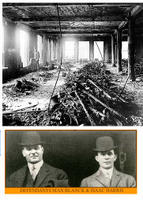Sent by Carlos Alejandro
Top Picture
Howie Silverstein, Jacqueline Lee, Carlos Alejandro
Bottom Picture
Sheldon Austin, Donald Singletary, Billy Owens, Bruce Buell
Howie Silverstein, Carlos Alejandro, Eddie Moy
I think Donald Singletary had a cousin Ronnie Bly who played football for the Giants .. Donald was a great kid, he was like our own Will Smith ...one time he came to my house to play after school and I remember for years the story my Mom used to tell how she felt uncomfortable the time we had a 'girl' cleaning the house and I brought a black friend over to play .. the 'girl' of course was black too ...... Billy Owens was also one of the nicest guys, smiled and laughed a lot ...I played against him in little league, he played for Mariner's Temple which was predominantly if not all black ... one of my favorite little league stories is from a game against Mariner's Temple ... it was Spring of either '62 or '63 and it was a playoff game which meant win the game or the season is over .. I was playing right field, the game was tied in extra innings and they had a runner on 2nd base... on the last play of the game there's a base hit to me in right field, I charged the ball and fired home trying to throw out the runner from 2nd . it was a pretty good throw but the runner still scored ahead of the tag and Mariner's beats us, ending our season ... as I'm walking off the field dejected a tall black priest walks out of their dugout right up to me ... puts a hand on my shoulder and says, "..son, Mohammed himself couldn't have made a better throw .." ... one of those special moments that could only have happened on the LES ..
Howie
a follow up from Carlos
Billy Owens was one of the nicest guys I've ever known. We went on to JHS 22 together. He used to walk from the Smith Houses past my apartments, the LaGuardia Houses, and we would walk to Houston and Columbia Streets together until he got a bus pass. Sometimes he would walk with me to my buildings and then pick up the bus. He and Gary Jones were good friends. Didn't Gary play Little League, too. Does anybody know what happened to any of the other kids like: Rochelle Murphy, Eileen Rivela, Elaine Katz, Jacy ? (from Pearl Street?), Trudy Babits, Eddie Moy, ...
What was the name of the store right across the street from the school? That's where I would get those Ivy League plasticky book covers for my notebooks and or textbooks.
Here's a memory I have: One day at lunch time a bunch of us, a big bunch, decided to go down to Battery Park to see the President's motorcade at South Ferry. John F. Kennedy in a big black Lincoln with the weird doors. When we got back Mrs. Meiers was confused about why we had "cut" class but when she heard she just kinda laughed it off. Anybody else remember that?
from Donald Singletary
KD COBRA said...
FROM DONALD SINGLETARY - WOW! What a great surprise. I lucked up on this blog while "Googling" myself!
That second photo with Billy Owens and Howard Silverstein, etc. -- that's NOT me in the photo. Don't know who it is.
Anyway, I've been putting together some stuff for an LES book of my own. I connected with a writer who used to teach at P.S. 2 -- Leslie Kandell. She has found many of her former students. I also have some old photos I'd love to share. Glad you guys are well. Sadly, Billy died in November 1990. Many others have passed too. Glad you guys are all right. There's a Smith Projects Reunion this weekend on Saturday in the park by the Gym. Many "old-timers" come around.
Would love to keep in touch please email me at:
kdonald53@aol.com
thanks!






















